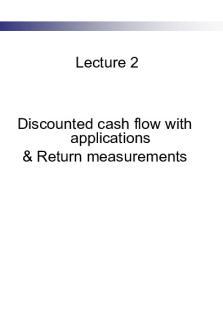Discounted Cash flow Investment Analysis PDF

| Title | Discounted Cash flow Investment Analysis |
|---|---|
| Course | Introduction to Finance |
| Institution | Concordia University |
| Pages | 2 |
| File Size | 48.4 KB |
| File Type | |
| Total Downloads | 68 |
| Total Views | 149 |
Summary
A breakdown of important concepts related to the cash flow analysis...
Description
Using Discounted Cash-Flow Analysis to Make Investment Decisions How should the cash flows properly attributable to a proposed new project be calculated? Here is a checklist to bear in mind when forecasting a project’s cash flows: • Discount cash flows, not profits. • Estimate the project’s incremental cash flows—that is, the difference between the cash flows with the project and those without the project. • Include all indirect effects of the project, such as its impact on the sales of the firm’s other products. • Forget sunk costs. • Include opportunity costs, such as the value of land which you could otherwise sell. • Beware of allocated overhead charges for heat, light, and so on. These may not reflect the incremental effects of the project on these costs. • Remember the investment in working capital. As sales increase, the firm may need to make additional investments in working capital and, as the project finally comes to an end, it will recover these investments. The MACRS tax depreciation schedules assume zero salvage value at the end of assets’ depreciable lives. For reports to shareholders, however, positive expected salvage values are often recognized. For example, Blooper’s financial statements might assume that its $10 million investment in mining equipment would be worth $2 million in Year 6. In this case, the depreciation reported to shareholders would be based on the difference between investment and salvage value, that is, $8 million. Straight-line depreciation would be $1.6 million per year.
• Do not include debt interest or the cost of repaying a loan. When calculating NPV, assume that the project is financed entirely by the shareholders and that they receive all the cash flows. This isolates the investment decision from the financing decision.
How can the cash flows of a project be computed from standard financial statements?
Project cash flow does not equal profit. You must allow for changes in working capital as well as noncash expenses such as depreciation. Also, if you use a nominal cost of capital, consistency requires that you forecast nominal cash flows—that is, cash flows that recognize the effect of inflation.
How is the company’s tax bill affected by depreciation and how does this affect project value?
Depreciation is not a cash flow. However, because depreciation reduces taxable income, it reduces taxes. This tax reduction is called the depreciation tax shield. Modified Accelerated Cost Recovery System
Using Discounted Cash-Flow Analysis to Make Investment Decisions (MACRS) depreciation schedules allow more of the depreciation allowance to be taken in early years than under straight-line depreciation. This increases the present value of the tax shield.
How do changes in working capital affect project cash flows?
Increases in net working capital such as accounts receivable or inventory are investments, and therefore use cash—that is, they reduce the net cash flow provided by the project in that period. When working capital is run down, cash is freed up, so cash flow increases....
Similar Free PDFs

FINC 440 7980 Discounted Cash Flow
- 13 Pages

Chapter 7 Cash Flow Analysis
- 50 Pages

Free Cash Flow Model
- 4 Pages

Cash Flow Statement - StockTrak
- 10 Pages

Easy Cash Flow Problem
- 2 Pages

Cash flow statement
- 3 Pages

Cash Flow Netflix
- 2 Pages
Popular Institutions
- Tinajero National High School - Annex
- Politeknik Caltex Riau
- Yokohama City University
- SGT University
- University of Al-Qadisiyah
- Divine Word College of Vigan
- Techniek College Rotterdam
- Universidade de Santiago
- Universiti Teknologi MARA Cawangan Johor Kampus Pasir Gudang
- Poltekkes Kemenkes Yogyakarta
- Baguio City National High School
- Colegio san marcos
- preparatoria uno
- Centro de Bachillerato Tecnológico Industrial y de Servicios No. 107
- Dalian Maritime University
- Quang Trung Secondary School
- Colegio Tecnológico en Informática
- Corporación Regional de Educación Superior
- Grupo CEDVA
- Dar Al Uloom University
- Centro de Estudios Preuniversitarios de la Universidad Nacional de Ingeniería
- 上智大学
- Aakash International School, Nuna Majara
- San Felipe Neri Catholic School
- Kang Chiao International School - New Taipei City
- Misamis Occidental National High School
- Institución Educativa Escuela Normal Juan Ladrilleros
- Kolehiyo ng Pantukan
- Batanes State College
- Instituto Continental
- Sekolah Menengah Kejuruan Kesehatan Kaltara (Tarakan)
- Colegio de La Inmaculada Concepcion - Cebu








